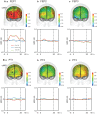Examination of the Prefrontal Cortex Hemodynamic Responses to the Fist-Edge-Palm Task in Naïve Subjects Using Functional Near-Infrared Spectroscopy
- PMID: 33633554
- PMCID: PMC7901956
- DOI: 10.3389/fnhum.2021.617626
Examination of the Prefrontal Cortex Hemodynamic Responses to the Fist-Edge-Palm Task in Naïve Subjects Using Functional Near-Infrared Spectroscopy
Abstract
The Fist-Edge-Palm (FEP) task, a manual hand task, has been used to detect frontal dysfunctions in clinical situations: its performance failures are observed in various prefrontal cortex (PFC)-related disorders, including schizophrenia. However, previous imaging studies reported that the performance of the FEP task activated motor-related areas, but not the PFC. Here, we aimed to investigate the relationships between the performance of the FEP task and PFC functions. Hemodynamic activity in the PFC, including the dorsolateral PFC (area 46) and frontal pole (area 10), was recorded. Healthy young subjects performed the FEP task as well as a palm tapping (PT) task (control task) three times. The subjects also completed a Wisconsin Card Sorting Test (WCST) and Schizotypal Personality Scale (STA) questionnaire. We found that hemodynamic activity (Oxy-Hb) in the PFC increased in the first trial of the FEP task but decreased considerably in the second and third trials compared to the PT task. The number of performance errors in the FEP task also decreased in the second and third trials. Error reduction (i.e., learning) in the FEP task between the first and second trials was negatively correlated with schizotypal trait and the number of perseveration errors in the WCST. Furthermore, changes in the PFC hemodynamic activity between the first and second trials were positively correlated with error reduction in the FEP task between the first and second trials, and negatively correlated with the number of perseveration errors in the WCST. These results suggest that learning in the FEP task requires PFC activation, which is negatively associated with perseveration errors in the WCST. The results further suggest that the FEP task, in conjunction with near-infrared spectroscopy, may be useful as a diagnostic method for various disorders with PFC dysfunction.
Keywords: FEP task; WCST; fNIRS; prefrontal cortex; schizophrenia.
Copyright © 2021 Kobayashi, Iwama, Nishimaru, Matsumoto, Setogawa, Ono and Nishijo.
Conflict of interest statement
The authors declare that the research was conducted in the absence of any commercial or financial relationships that could be construed as a potential conflict of interest.
Figures






Similar articles
-
A semi-immersive virtual reality incremental swing balance task activates prefrontal cortex: a functional near-infrared spectroscopy study.Neuroimage. 2014 Jan 15;85 Pt 1:451-60. doi: 10.1016/j.neuroimage.2013.05.031. Epub 2013 May 17. Neuroimage. 2014. PMID: 23684867
-
A regulation role of the prefrontal cortex in the fist-edge-palm task: evidence from functional connectivity analysis.Neuroimage. 2008 Jul 15;41(4):1345-51. doi: 10.1016/j.neuroimage.2008.04.026. Epub 2008 Apr 18. Neuroimage. 2008. PMID: 18495496
-
Prefrontal cortex connectivity dysfunction in performing the Fist-Edge-Palm task in patients with first-episode schizophrenia and non-psychotic first-degree relatives.Neuroimage Clin. 2015 Sep 18;9:411-7. doi: 10.1016/j.nicl.2015.09.008. eCollection 2015. Neuroimage Clin. 2015. PMID: 26594623 Free PMC article.
-
Activation of the prefrontal cortex during the Wisconsin Card Sorting Test as measured by multichannel near-infrared spectroscopy.Neuropsychobiology. 2006;53(2):70-6. doi: 10.1159/000091722. Epub 2006 Feb 23. Neuropsychobiology. 2006. PMID: 16511337
-
[Decision-making and schizophrenia].Encephale. 2011 Dec;37 Suppl 2:S110-6. doi: 10.1016/S0013-7006(11)70036-7. Encephale. 2011. PMID: 22212839 Review. French.
Cited by
-
Neural Mechanisms of Neuro-Rehabilitation Using Transcranial Direct Current Stimulation (tDCS) over the Front-Polar Area.Brain Sci. 2023 Nov 18;13(11):1604. doi: 10.3390/brainsci13111604. Brain Sci. 2023. PMID: 38002563 Free PMC article. Review.
-
Young female participants show blunted placebo effects associated with blunted responses to a cue predicting a safe stimulus in the right dorsolateral prefrontal cortex.Front Neurosci. 2022 Oct 3;16:1001177. doi: 10.3389/fnins.2022.1001177. eCollection 2022. Front Neurosci. 2022. PMID: 36263366 Free PMC article.
-
Functional near-infrared spectroscopy of medical students answering various item types.Front Psychol. 2023 Jun 12;14:1178753. doi: 10.3389/fpsyg.2023.1178753. eCollection 2023. Front Psychol. 2023. PMID: 37377693 Free PMC article.
-
Involvement of the Rostromedial Prefrontal Cortex in Human-Robot Interaction: fNIRS Evidence From a Robot-Assisted Motor Task.Front Neurorobot. 2022 Mar 17;16:795079. doi: 10.3389/fnbot.2022.795079. eCollection 2022. Front Neurorobot. 2022. PMID: 35370598 Free PMC article.
-
Cognitive Processes and Resting-State Functional Neuroimaging Findings in High Schizotypal Individuals and Schizotypal Personality Disorder Patients: A Systematic Review.Brain Sci. 2023 Apr 4;13(4):615. doi: 10.3390/brainsci13040615. Brain Sci. 2023. PMID: 37190580 Free PMC article. Review.
References
-
- Badoud S., Borgognon S., Cottet J., Chatagny P., Moret V., Fregosi M., et al. (2017). Effects of dorsolateral prefrontal cortex lesion on motor habit and performance assessed with manual grasping and control of force in macaque monkeys. Brain Struct. Funct. 222 1193–1206. 10.1007/s00429-016-1268-z - DOI - PMC - PubMed
LinkOut - more resources
Full Text Sources
Other Literature Sources
Miscellaneous

